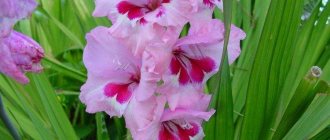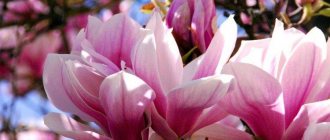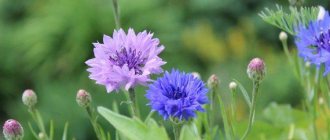general information
Among hundreds of species there are evergreen and deciduous. There are completely dwarf creeping varieties, and there are tall giants. Most of them are heat-loving, but some are still able to withstand severe frosts.
The tallest and most spreading trees stretch up to 10 m. Most often, bushes up to 3-5 cm in diameter are found, and species up to 1.5-2 m are considered miniature. Creeping varieties are classified separately. By the way, they are good for green hedges and arches.
Euonymus is a flowering plant that blooms towards the end of spring. Its buds are not very noticeable, unlike the colorful leaves, which by autumn collect all shades from yellow to purple. In addition, long earrings, which also gradually change shade, look unusual. Keep in mind that euonymus is a poisonous plant.
Photo: sadogorod25.ru
general description
The plant of the euonymus genus is a winter-hardy ornamental shrub or low tree. The genus contains deciduous and evergreen varieties, on the shoots of which, in most species, coarse growths form with age.
The plant is characterized by slow development, giving no more than 10-12 cm of annual growth. But the euonymus can live in the garden for up to 50 years or longer, the first 15 of which it will grow. At a more mature age, his energy will be spent on maintaining the crown and replacing non-viable shoots with young ones.
Important! The plant is poisonous and contains alkaloids; its fruits should not be eaten, and you need to wear gloves when handling it!
Types of euonymus
In our latitudes, only two species are common - European and warty. But we will tell you about a few more quite popular ones!
European euonymus
There are two main subspecies of this euonymus - shrubby and tree-like. The tree, depending on the conditions of the region, can grow up to 8 m. Frost resistance is average.
Photo: pinterest.com
Warty euonymus
A medium-sized shrub up to 1.5 m is notable for its very slow growth and high frost resistance. Despite its not very romantic name, it is surprisingly decorative. The shoots become overgrown with characteristic thickenings.
Photo: stroyremned.ru
Broadleaf euonymus
This is a tall shrub up to 5 m with abundant flowering and a pungent aroma. But this species is more often grown for medicinal purposes. Therefore, it is not so in demand among gardeners and landscape designers.
Photo: flower.onego.ru
Euonymus Fortune
And again frost-resistant, and also very decorative. This is a very compact Chinese euonymus in the form of a variegated creeping shrub up to 50 cm.
Photo: ozon.ru
Great-winged euonymus
A tall tree-like shrub grows well in the shade. But still, in sunny areas it is much more beautiful, and is grown mainly in the form of single plantings.
Photo: stroyremned.ru
Japanese euonymus
A heat-loving species that does not tolerate temperatures below +5 degrees. But the good news is that it winters well indoors or in a covered greenhouse. Therefore, it is mainly grown in tubs.
Photo: vivaiocipolloni.it
Dwarf euonymus
It is easily distinguished by its atypical narrow lanceolate leaves with curved tips. It grows up to 1 m in height, but quickly expands in width and covers entire areas.
Photo: sadik.tomsk.ru
Celosia (60 photos): types, planting and proper care
Top dressing
In principle, additional feeding is not required . However, it would not be amiss to feed the plant with complex mineral fertilizers in the spring and summer. This is not required more than once a month.
Which fertilizers should be used depends on the activity of the plant. The dwarf Japanese euonymus is known to have two growth waves . The fact that the growth period is over is indicated by the appearance of buds (cones) at the top of each shoot.
And vice versa, when these buds begin to open and new leaves are formed, another wave of shrub growth is expected.
So, at the moment when activity is just beginning, you should feed the plant with nitrogen fertilizers. In the middle of the period, you can use complex fertilizers , and at the moment when the buds are formed - phosphorus-potassium fertilizers .
Euonymus care
Euonymus has rather banal and restrained requirements. A little moderation in everything - and it will grow well and delight you with its beauty!
Temperature
The ideal summer temperature for euonymus is about 20 degrees. For indoor flowerpots in winter it needs to be lowered to 6-12 degrees so that the plant gains strength by spring.
Photo: distano.ru
Lighting
The light should be bright, but diffused, because aggressive direct rays can leave burns and affect the color of the leaves. Light requirements may vary between varieties.
Photo: idoom.ru
Watering
In summer, you will definitely need abundant watering and regular spraying, because dry soil and dry air are the first causes of leaf loss. But in winter, euonymus hardly needs additional moisture at all.
Photo: pinterest.com
The soil
Any soil is suitable, but it must be light and loose. It is good to use leaf soil with turf and organic matter, and also add peat and sand.
Photo: dimgou.ru
Fertilizers and fertilizing
Euonymus reacts sensitively to feeding. Moreover, in this case, you can safely alternate mineral complexes and organic matter with an interval of 1-2 weeks.
Photo: olalastudio.ru
Trimming
The bush is pruned for decorative purposes to create a neat and well-groomed crown. In addition, for branching in the spring, fresh shoots must be pinched.
Photo: cemicvet.mediasole.ru
Wintering
This applies to outdoor plants that will remain directly in the garden. Winter-hardy species do not require additional care and tolerate even -25 degrees in the snow. If the branches are partially frozen, they will recover over the season.
Photo: speakingflower.ru
Transfer
And this point applies to indoor and potted plants. Decorative euonymus gradually depletes the soil, so it is recommended that even mature, slow-growing bushes be replanted once every 2-3 years.
Photo: idoom.ru
Lilies of the valley (50 photos): types, planting and proper care
Rules for creating an optimal microclimate
For euonymus, growing at home is impossible without maintaining certain conditions. The plant is considered unpretentious, but feels best in a specific environment.
Where to place
The euonymus is ideally placed on a windowsill that faces southeast or southwest. Stagnation of air in the room is unacceptable, but there is no need to create drafts. Regular ventilation to bring in fresh air is carried out in winter.
In summer, the bush can be taken out into the open. With strong shading and the use of exclusively artificial lighting, the plant does not form a beautiful crown.
Lighting organization
Proper indoor care does not involve forced shading or lighting. Enough natural conditions. At the same time, there is no need to place the flower far from the window. Most types of euonymus love bright light and do not suffer from direct rays of the sun.
Intense light will cause foliage color to fade. This must be taken into account when taking care of a certain appearance of the plant. The complete absence of natural sunlight prevents the splendor of the crown.
Air temperature around
In the description of a flower, 20°C is usually indicated as the optimal ambient temperature. If the environment is warmer in winter, the plant may shed its leaves. For winter, 12–18°C is suitable for it.
Domestic varieties normally tolerate temperatures of 3–5°C, but lower values are detrimental to them. In summer, a comfortable value will be 22–25°C, but without air stagnation.
Ambient humidity
Maintaining high air humidity of 60–70% is optimal for euonymus. To do this, you can place a vessel with water next to it and regularly spray the foliage.
If you refuse this, the plant will not be harmed. It tolerates dry air well, but wet cleaning of greenery is necessary. You can give the bush a warm shower no more than once a week.
Reproduction and planting of euonymus
Colored and variegated varieties are propagated only vegetatively in order to preserve their characteristics. Garden plants are easiest to propagate by layering. Just bend the low shoots to the ground in a groove, secure with staples, dig in, leaving only the top, and wait. Once the roots appear, they can be separated and replanted.
Cuttings are a universal method for both potted and outdoor plants. At the beginning of summer, cut apical cuttings of about 7 cm with an internode, treat them with a stimulant and root them in peat with sand under a film. They can be transplanted in 2 months.
At the beginning of the season, root children with roots about 30 cm long can be separated from the main plant. They are simply immediately transplanted to a permanent place. And dwarf species with abundant root shoots can be propagated completely painlessly by dividing the rhizomes.
Photo: idoom.ru
Location, light requirements
The choice of location depends on the selected species. If the area is open to the sun, it is better to give preference to Maak's euonymus. The European or warty species thrives in partial shade or even shade among sparsely planted large trees. And yet, where the sun practically does not look at all, the winged or Sakhalin euonymus will feel best. They are also best to choose when planting on a slope, since they grow well and over time root the lower shoots, delaying landslides.
A lack of light for shrubs with poor shade tolerance will lead to the growth of a thin and shapeless crown, which will significantly lose in decorativeness.
Pest and disease control
Spider mites, mealybugs and codling moths are especially dangerous. Less commonly, red mites, scale insects and moths settle on trees. All of them spoil and destroy leaves, but complex insecticides help against all of them.
Drying of branches and necrosis of the bark most often occurs due to a fungal infection. The second most common fungus is ascochyta blight, as a result of which the leaves become covered with brown spots that gradually lighten. You need to get rid of the affected parts of the plant, and then treat everything with Bordeaux mixture.
Photo: fb.ru
Yasnotka (60 photos): types, planting and proper care
Difficulties in growing
A plant, especially an adult, may periodically experience problems.
| Problem | Cause | How to fight | Prevention |
| Leaves fade, curl, edges dry out | Too much sun rays | Shade | Choose the optimal location |
| Leaves fade, curl, edges dry out | Overmoistening | Let the earthen coma dry | Optimize the watering regime |
| Leaves fall, root system dies | Overmoistening | Dry the earthen lump | Optimize watering |
Euonymus – photo
The euonymus is so spectacular that it is impossible to deny yourself the pleasure of admiring it. So don't refuse!
Photo: it.wow-plants.com
Photo: prorastet.ru
Photo: vsevdom.net
Photo: domashniecvety.ru
Photo: pinterest.ru
Photo: mykaleidoscope.ru
Photo: spb.tiu.ru
Photo: en.wikipedia.org
Photo: domashniecvety.ru
Photo: gazon7777.ru
Photo: stroy-podskazka.ru
Photo: ogorodnik24.ru
Photo: my-farmer.ru
Photo: jalita.com
Photo: alleyann.ru
Photo: energysad.ru
Photo: e-semena.ru
Photo: stylishgarden.ru
Photo: idoom.ru
Photo: alexbego.ru
Photo: regionoperator.ru
Photo: princely-garden.ru
Photo: ceneo.pl
Did you like the post? Subscribe to our channel in Yandex.Zen, it really helps us in our development!
Trimming
Euonymus lends itself perfectly to molding; they can be given any desired shape. They endure the procedure painlessly. Sanitary pruning is mandatory for them. Old shoots must be replaced with new ones in order to extend not only the life of the plant, but also to maintain their visual appeal. It is necessary to wear gloves when working with the bush because of the poisonous sap of the plant!
When molding the crown of the euonymus, it should be taken into account that due to the slow growth, it will not be possible to correct the mistake made soon.
Cultivation
Possessing highly decorative properties, Fortune's euonymus is used in different ways in landscape design. Here are just some of the options:
- rocky gardens;
- imitation lawns;
- alpine slides;
- borders and parterres;
- coniferous compositions;
- heather, Japanese gardens;
- decor for garden buildings (gazebos, pergolas) and furniture (benches);
- decoration of artificial reservoirs;
- mixborders;
- solo plantings;
- vertical landscaping of the site;
- If grown as a shrub rather than a ground cover, Fortune's euonymus will look quite good in a hedge.
Another important feature of Fortune's euonymus is that it tolerates dirty, polluted air and dust well. Therefore, it is often used in urban landscape design of local areas, in park compositions, and squares.











